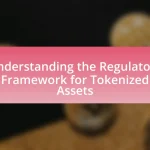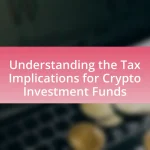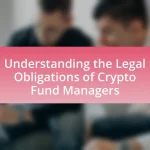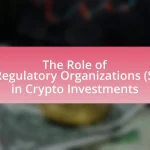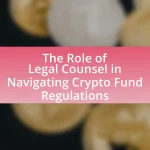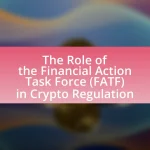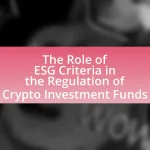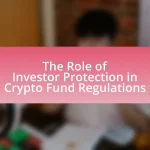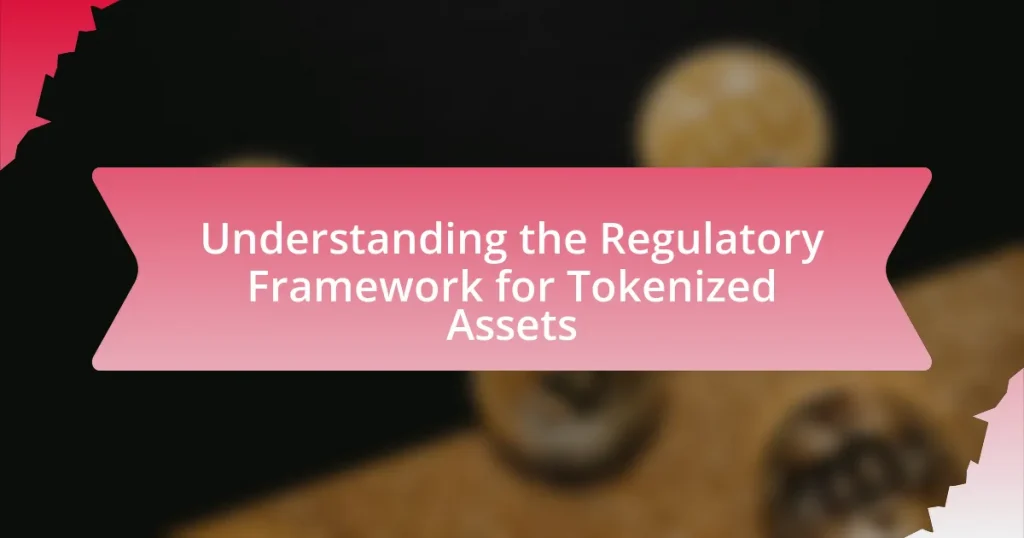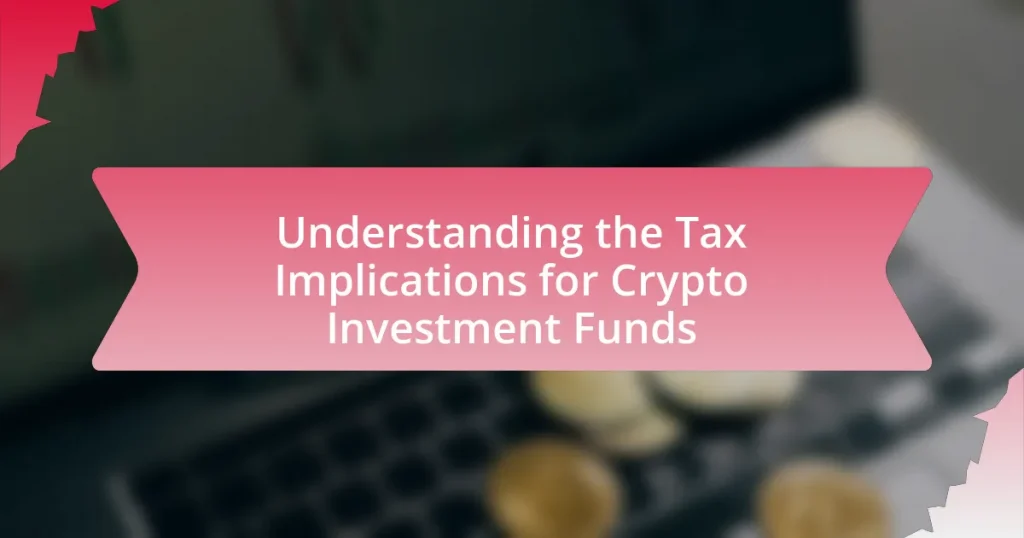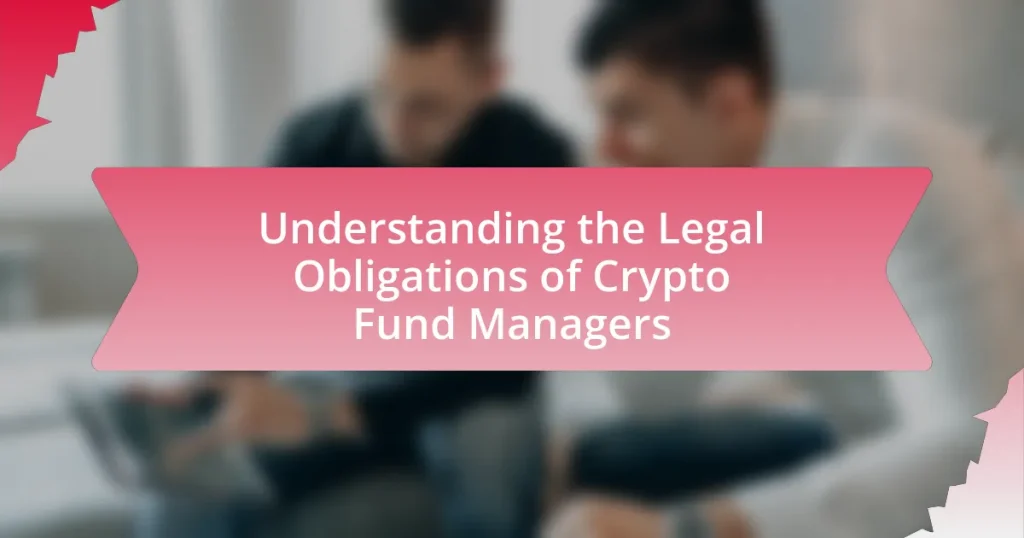The main entity of the article is the regulatory framework for tokenized assets, which includes laws and guidelines governing the issuance, trading, and management of digital tokens that represent real-world assets. The article outlines the differences between tokenized and traditional assets, highlighting key characteristics such as divisibility, liquidity, and transparency. It discusses the components of the regulatory framework, including compliance requirements and oversight bodies, while addressing the challenges and risks associated with non-compliance. Additionally, the article examines the benefits of a robust regulatory environment for investors and the evolving global regulations that aim to balance innovation with investor protection.
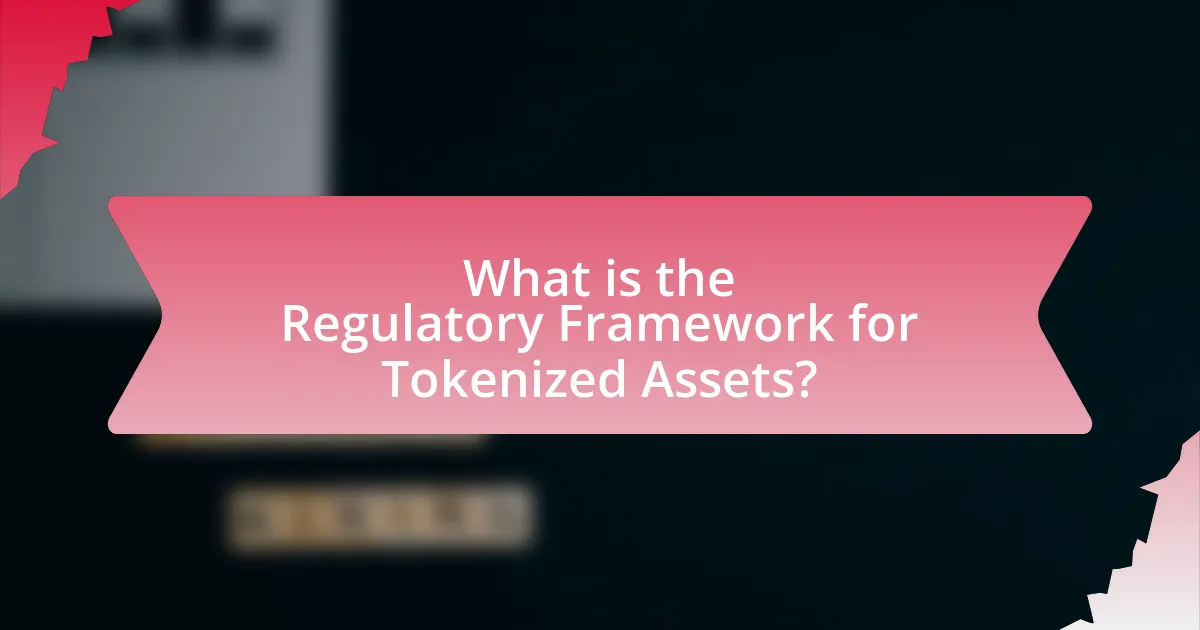
What is the Regulatory Framework for Tokenized Assets?
The regulatory framework for tokenized assets encompasses a set of laws and guidelines that govern the issuance, trading, and management of digital tokens representing real-world assets. This framework varies by jurisdiction but generally includes securities laws, anti-money laundering (AML) regulations, and consumer protection laws. For instance, in the United States, the Securities and Exchange Commission (SEC) applies the Howey Test to determine if a token qualifies as a security, thereby subjecting it to federal securities regulations. In the European Union, the Markets in Crypto-Assets (MiCA) regulation aims to create a comprehensive regulatory environment for crypto-assets, including tokenized assets, ensuring investor protection and market integrity. These regulations are designed to mitigate risks associated with fraud, market manipulation, and financial instability while promoting innovation in the digital asset space.
How do tokenized assets differ from traditional assets?
Tokenized assets differ from traditional assets primarily in their digital representation and the underlying technology used for ownership transfer. Traditional assets, such as real estate or stocks, exist in physical or centralized forms and require intermediaries for transactions, while tokenized assets are represented as digital tokens on a blockchain, enabling peer-to-peer transactions without intermediaries. This blockchain technology enhances transparency, security, and efficiency in asset management, as transactions are recorded in an immutable ledger. Additionally, tokenized assets can be fractionalized, allowing for smaller investment amounts, which is not typically possible with traditional assets.
What are the key characteristics of tokenized assets?
Tokenized assets possess several key characteristics, including divisibility, liquidity, transparency, and programmability. Divisibility allows assets to be broken down into smaller units, enabling fractional ownership, which increases accessibility for investors. Liquidity is enhanced through tokenization, as assets can be traded on various platforms, facilitating quicker transactions compared to traditional markets. Transparency is achieved via blockchain technology, which provides a public ledger that records all transactions, ensuring trust and accountability. Lastly, programmability allows for smart contracts to automate processes and enforce terms without intermediaries, streamlining operations and reducing costs. These characteristics collectively enhance the efficiency and appeal of tokenized assets in the financial ecosystem.
Why are tokenized assets gaining popularity in the financial market?
Tokenized assets are gaining popularity in the financial market due to their ability to enhance liquidity and accessibility. By converting physical or traditional assets into digital tokens on a blockchain, these assets can be traded more easily and efficiently, allowing for fractional ownership and broader participation. According to a report by Deloitte, tokenization can reduce transaction costs by up to 90% and increase market efficiency, making it an attractive option for investors and institutions alike. Additionally, the transparency and security provided by blockchain technology further bolster investor confidence, contributing to the growing interest in tokenized assets.
What are the main components of the regulatory framework?
The main components of the regulatory framework for tokenized assets include legal definitions, compliance requirements, enforcement mechanisms, and oversight bodies. Legal definitions establish the classification of tokenized assets, determining whether they are treated as securities, commodities, or other financial instruments. Compliance requirements outline the obligations for issuers and platforms, such as anti-money laundering (AML) and know your customer (KYC) regulations. Enforcement mechanisms provide the tools for regulatory bodies to impose penalties or sanctions for non-compliance. Oversight bodies, such as financial regulatory authorities, are responsible for monitoring and enforcing the regulations to ensure market integrity and investor protection. These components collectively create a structured environment for the operation and management of tokenized assets.
Which regulatory bodies oversee tokenized assets?
The regulatory bodies that oversee tokenized assets include the U.S. Securities and Exchange Commission (SEC), the Commodity Futures Trading Commission (CFTC), and the Financial Conduct Authority (FCA) in the United Kingdom. The SEC regulates tokenized assets that qualify as securities under U.S. law, ensuring compliance with securities regulations. The CFTC oversees derivatives and commodities, which can include certain tokenized assets. The FCA regulates financial markets in the UK, including aspects of tokenized assets that fall under its jurisdiction. These bodies establish guidelines and frameworks to ensure market integrity and investor protection in the evolving landscape of tokenized assets.
What laws and regulations apply to tokenized assets?
Tokenized assets are primarily governed by securities laws, anti-money laundering (AML) regulations, and tax laws. In many jurisdictions, if a tokenized asset represents ownership in a real-world asset or a share in a company, it is classified as a security and must comply with the relevant securities regulations, such as the Securities Act of 1933 in the United States. Additionally, tokenized assets must adhere to AML regulations to prevent illicit activities, which often require Know Your Customer (KYC) processes. Tax laws also apply, as transactions involving tokenized assets may trigger capital gains taxes. These legal frameworks ensure that tokenized assets are treated similarly to traditional financial instruments, providing investor protection and regulatory oversight.
What challenges exist within the regulatory framework?
The regulatory framework for tokenized assets faces several challenges, including lack of clarity, inconsistent regulations across jurisdictions, and the rapid pace of technological innovation. Lack of clarity arises from ambiguous definitions of tokenized assets, which complicates compliance for businesses. Inconsistent regulations across jurisdictions create a fragmented landscape, making it difficult for companies to operate internationally. Additionally, the rapid pace of technological innovation often outstrips regulatory responses, leading to gaps in oversight and potential risks for investors. These challenges hinder the effective implementation of regulations and can stifle innovation in the tokenized asset space.
How do regulatory uncertainties impact market participants?
Regulatory uncertainties significantly impact market participants by creating an unpredictable environment that affects investment decisions and operational strategies. When regulations are unclear or subject to change, market participants may face increased risks, leading to hesitance in capital allocation and innovation. For instance, a study by the International Monetary Fund in 2021 highlighted that ambiguous regulatory frameworks can deter investment in emerging markets, as investors seek stability and clarity before committing resources. This hesitance can result in reduced market liquidity and slower adoption of tokenized assets, ultimately hindering market growth and technological advancement.
What are the risks associated with non-compliance?
Non-compliance with regulatory frameworks for tokenized assets poses significant risks, including legal penalties, financial losses, and reputational damage. Legal penalties can arise from fines imposed by regulatory bodies, which can reach millions of dollars depending on the severity of the violation. Financial losses may occur due to the inability to operate legally, resulting in lost revenue opportunities and potential lawsuits from investors or stakeholders. Reputational damage can lead to a loss of trust among customers and partners, which is critical in the competitive landscape of tokenized assets. For instance, companies that fail to comply with the Securities and Exchange Commission regulations may face enforcement actions that not only incur costs but also hinder future business prospects.
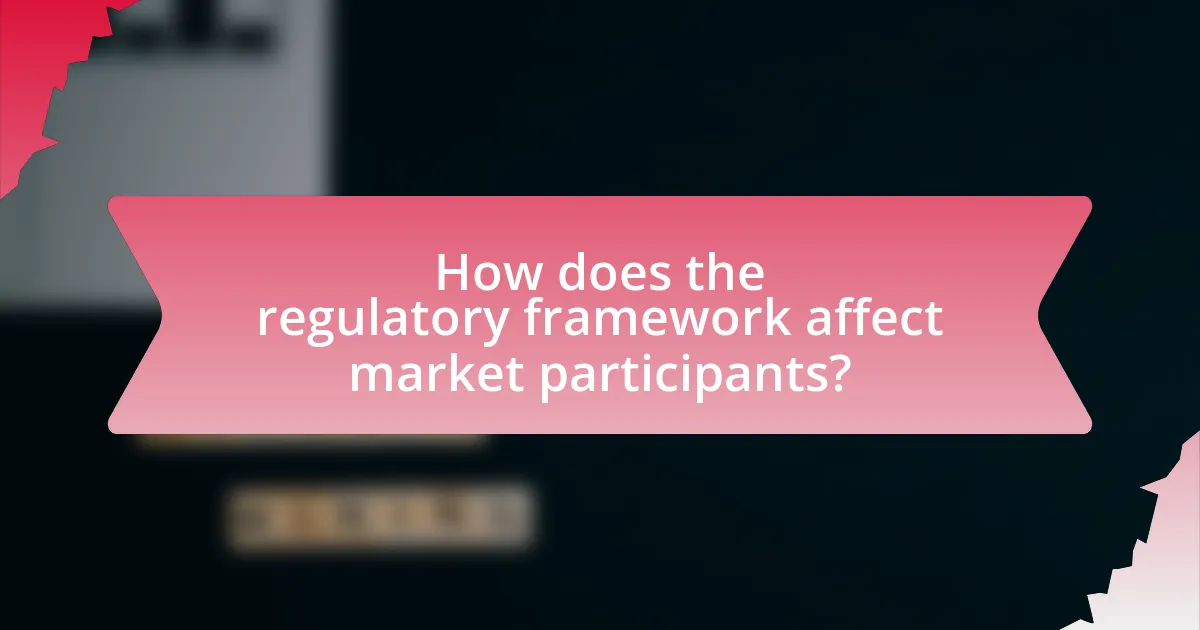
How does the regulatory framework affect market participants?
The regulatory framework significantly impacts market participants by establishing rules and guidelines that govern their operations. These regulations dictate compliance requirements, risk management practices, and operational standards, which market participants must adhere to in order to operate legally and effectively. For instance, the implementation of the Financial Action Task Force (FATF) guidelines on anti-money laundering (AML) and counter-terrorism financing (CTF) has compelled market participants to enhance their due diligence processes and reporting mechanisms. This ensures that they mitigate risks associated with illicit activities, thereby fostering a more secure trading environment. Additionally, regulatory clarity can influence investment decisions, as participants may be more inclined to engage in markets that are well-regulated, reducing uncertainty and enhancing market stability.
What obligations do issuers of tokenized assets have?
Issuers of tokenized assets have the obligation to comply with applicable securities laws and regulations, ensuring that their offerings are registered or qualify for an exemption. This includes providing accurate and complete disclosures to investors regarding the nature of the tokenized asset, the rights associated with it, and any risks involved. Additionally, issuers must implement anti-money laundering (AML) and know your customer (KYC) procedures to verify the identities of their investors. Compliance with these obligations is essential to protect investors and maintain market integrity, as evidenced by regulatory frameworks established by authorities such as the U.S. Securities and Exchange Commission (SEC) and the Financial Action Task Force (FATF).
How must issuers ensure compliance with securities laws?
Issuers must ensure compliance with securities laws by conducting thorough due diligence and adhering to regulatory requirements. This includes registering their securities offerings with the appropriate regulatory bodies, such as the Securities and Exchange Commission (SEC) in the United States, or qualifying for an exemption from registration. Issuers must also provide accurate and complete disclosures to investors, ensuring that all material information is available to facilitate informed investment decisions. Furthermore, issuers should implement robust internal controls and compliance programs to monitor ongoing adherence to applicable laws and regulations. Historical data shows that non-compliance can lead to significant penalties, including fines and legal action, underscoring the importance of strict adherence to securities laws.
What reporting requirements must issuers fulfill?
Issuers must fulfill specific reporting requirements that include providing regular financial statements, disclosures about the tokenized assets, and compliance with applicable securities regulations. These requirements are mandated by regulatory bodies such as the Securities and Exchange Commission (SEC) in the United States, which enforces rules to ensure transparency and protect investors. For instance, issuers are typically required to file Form 10-K and Form 10-Q, which detail annual and quarterly financial performance, respectively. Additionally, issuers must disclose material events that could impact the value of the tokenized assets, ensuring that investors have access to relevant information for informed decision-making.
How do investors benefit from a robust regulatory framework?
Investors benefit from a robust regulatory framework by gaining increased confidence and security in their investments. This framework establishes clear rules and standards that protect investors from fraud and market manipulation, thereby fostering a stable investment environment. For instance, regulations such as the Securities Act of 1933 in the United States require transparency and disclosure from companies, which helps investors make informed decisions. Additionally, a strong regulatory framework can enhance market integrity, as seen in jurisdictions with stringent compliance requirements, leading to higher investor participation and potentially better returns.
What protections are in place for investors in tokenized assets?
Investors in tokenized assets are protected by a combination of regulatory frameworks, legal standards, and technological safeguards. Regulatory bodies, such as the Securities and Exchange Commission (SEC) in the United States, enforce compliance with securities laws, ensuring that tokenized assets are registered or qualify for exemptions, which provides transparency and reduces fraud risk. Additionally, smart contracts, which govern tokenized assets, are designed to execute transactions automatically and securely, minimizing the potential for human error or manipulation. Furthermore, many jurisdictions require custodial services for digital assets, ensuring that investors’ holdings are securely managed and protected against theft or loss. These measures collectively enhance investor confidence and safeguard their interests in the evolving landscape of tokenized assets.
How does regulation enhance market transparency?
Regulation enhances market transparency by establishing clear rules and standards that govern market participants’ behavior. These regulations require companies to disclose relevant financial information, operational practices, and risks, which allows investors to make informed decisions. For instance, the implementation of the Securities Exchange Act mandates public companies to file regular reports, ensuring that all stakeholders have access to the same information. This level of disclosure reduces information asymmetry, fostering trust and stability in the market. Additionally, regulatory oversight helps to deter fraudulent activities, further contributing to a transparent trading environment.
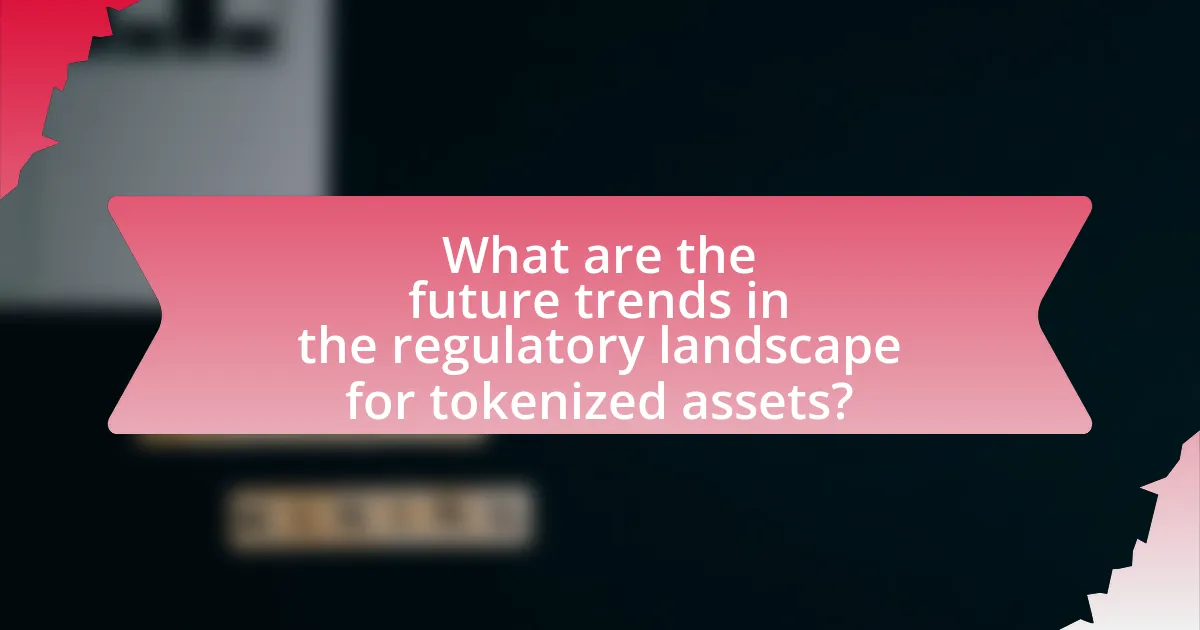
What are the future trends in the regulatory landscape for tokenized assets?
Future trends in the regulatory landscape for tokenized assets include increased clarity and standardization of regulations, as governments and regulatory bodies aim to create frameworks that facilitate innovation while ensuring investor protection. For instance, the European Union’s Markets in Crypto-Assets (MiCA) regulation, set to be implemented in 2024, seeks to provide a comprehensive regulatory framework for digital assets, including tokenized assets, thereby promoting legal certainty and fostering market growth. Additionally, jurisdictions are likely to adopt more tailored approaches, balancing the need for regulation with the desire to attract blockchain innovation, as seen in countries like Singapore and Switzerland, which have established favorable regulatory environments for tokenized assets.
How are global regulations evolving for tokenized assets?
Global regulations for tokenized assets are evolving towards increased clarity and standardization. Countries are developing frameworks that define the legal status of tokenized assets, with the European Union’s Markets in Crypto-Assets (MiCA) regulation being a significant example, aiming to provide a comprehensive regulatory approach by 2024. Additionally, jurisdictions like the United States are considering legislation that addresses the classification of tokens, focusing on consumer protection and anti-money laundering measures. This evolution is driven by the need to balance innovation in the blockchain space with regulatory oversight, as evidenced by the growing number of countries implementing or proposing regulations to ensure market integrity and investor safety.
What role do international standards play in regulation?
International standards play a crucial role in regulation by providing a framework for consistency and interoperability across jurisdictions. These standards help ensure that regulations are harmonized, facilitating international trade and investment, particularly in sectors like finance and technology. For instance, the International Organization for Standardization (ISO) develops standards that guide best practices and compliance, which can enhance the credibility and reliability of tokenized assets in global markets. By adhering to these standards, regulators can mitigate risks and protect consumers, as evidenced by the adoption of ISO 20022 in financial services, which standardizes electronic data interchange and improves transaction efficiency.
How might emerging technologies influence regulatory approaches?
Emerging technologies significantly influence regulatory approaches by necessitating adaptive frameworks that can address rapid advancements in areas such as blockchain, artificial intelligence, and digital currencies. For instance, the rise of blockchain technology has prompted regulators to explore new methods for ensuring transparency and security in financial transactions, leading to the development of specific guidelines for tokenized assets. The Financial Action Task Force (FATF) has issued recommendations that require countries to implement regulations for virtual assets, reflecting the need for a cohesive regulatory response to the challenges posed by these technologies. Additionally, the European Union’s Markets in Crypto-Assets (MiCA) regulation aims to create a comprehensive regulatory framework that addresses the unique characteristics of digital assets, demonstrating how emerging technologies drive the evolution of regulatory standards.
What best practices should market participants follow?
Market participants should adhere to compliance with regulatory requirements, ensuring they understand and follow the legal frameworks governing tokenized assets. This includes conducting thorough due diligence to verify the legitimacy of token offerings and ensuring that all transactions comply with anti-money laundering (AML) and know your customer (KYC) regulations. Additionally, participants should maintain transparent communication with stakeholders and regulators, fostering trust and accountability in their operations. According to the Financial Action Task Force (FATF), adherence to these practices is essential for mitigating risks associated with digital assets and ensuring market integrity.
How can issuers stay compliant with evolving regulations?
Issuers can stay compliant with evolving regulations by implementing a robust compliance management system that continuously monitors regulatory changes. This system should include regular training for staff on current laws, engagement with legal experts to interpret new regulations, and the use of technology to track compliance requirements. For instance, the Financial Action Task Force (FATF) updates its guidelines periodically, and issuers must adapt their practices accordingly to avoid penalties. Additionally, maintaining open communication with regulatory bodies can provide issuers with insights into upcoming changes, ensuring proactive compliance.
What strategies can investors use to navigate regulatory challenges?
Investors can navigate regulatory challenges by conducting thorough due diligence and staying informed about the evolving regulatory landscape. This involves regularly reviewing updates from regulatory bodies, engaging with legal experts, and participating in industry forums to understand compliance requirements. For instance, the Financial Action Task Force (FATF) provides guidelines that can help investors align their strategies with international standards. Additionally, investors can adopt a proactive approach by implementing robust compliance frameworks and utilizing technology solutions for monitoring regulatory changes. This strategy not only mitigates risks but also enhances investor confidence in the tokenized asset market.
